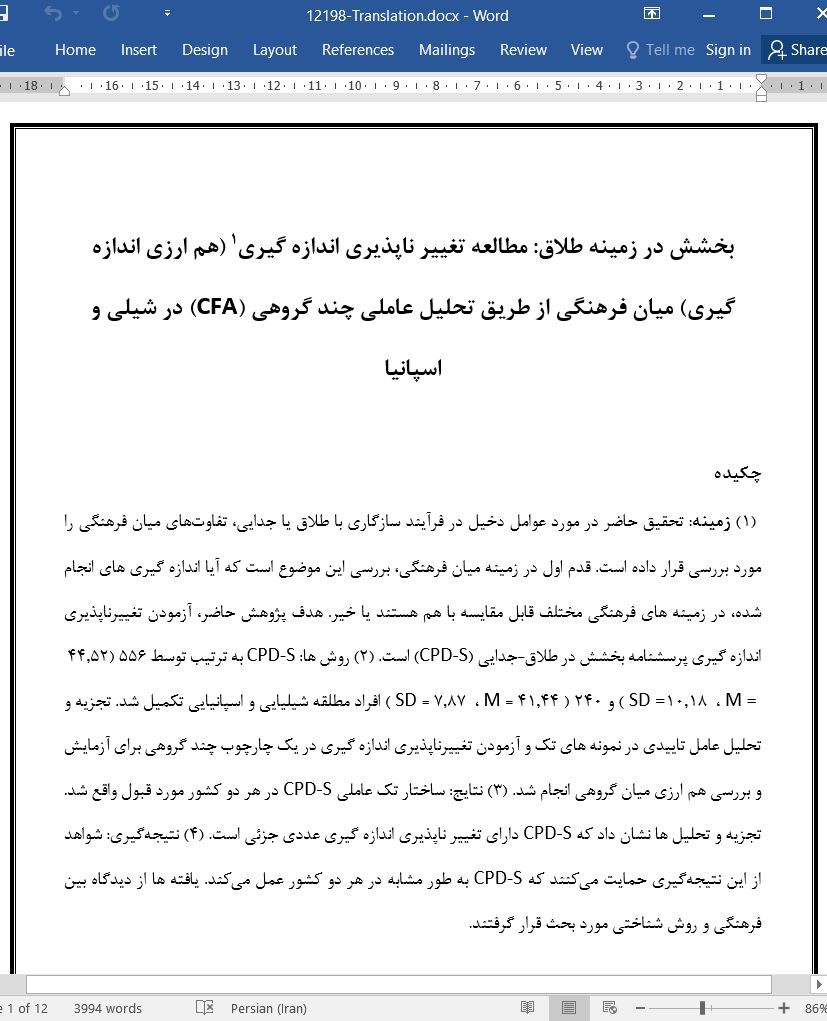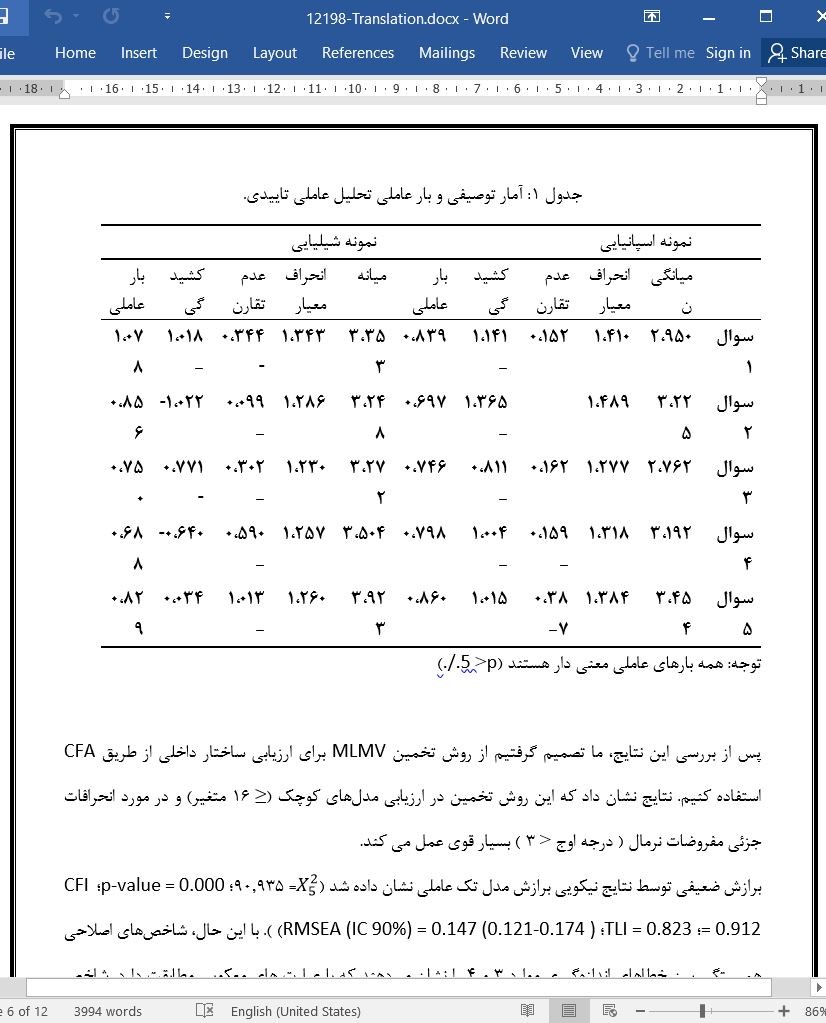
بخشش در زمینه طلاق: مطالعه تغییر ناپذیری اندازه گیری میان فرهنگی از طریق تحلیل عاملی چند گروهی
چکیده
(1) زمینه: تحقیق حاضر در مورد عوامل دخیل در فرآیند سازگاری با طلاق یا جدایی، تفاوتهای میان فرهنگی را مورد بررسی قرار داده است. قدم اول در زمینه میان فرهنگی، بررسی این موضوع است که آیا اندازه گیری های انجام شده، در زمینه های فرهنگی مختلف قابل مقایسه با هم هستند یا خیر. هدف پژوهش حاضر، آزمودن تغییرناپذیری اندازه گیری پرسشنامه بخشش در طلاق-جدایی (CPD-S) است. (2) روش ها: CPD-S به ترتیب توسط 556 (44.52 M = ، 10.18= SD ) و 240 ( 41.44 = M ، 7.87 = SD) افراد مطلقه شیلیایی و اسپانیایی تکمیل شد. تجزیه و تحلیل عامل تاییدی در نمونه های تک و آزمودن تغییرناپذیری اندازه گیری در یک چارچوب چند گروهی برای آزمایش و بررسی هم ارزی میان گروهی انجام شد. (3) نتایج: ساختار تک عاملی CPD-S در هر دو کشور مورد قبول واقع شد. تجزیه و تحلیل ها نشان داد که CPD-S دارای تغییر ناپذیری اندازه گیری عددی جزئی است. (4) نتیجهگیری: شواهد از این نتیجهگیری حمایت میکنند که CPD-S به طور مشابه در هر دو کشور عمل میکند. یافته ها از دیدگاه بین فرهنگی و روش شناختی مورد بحث قرار گرفتند.
1. مقدمه
طلاق عموما یک تجربه استرس زاست که شامل سازماندهی مجدد بسیاری از زمینه های زندگی است، و معمولاً پیامدهای نامطلوب بر بهزیستی روانشناختی و سلامت روان را به همراه خود دارد.
مطالعات قبلی در مورد فرآیند سازگاری با طلاق یا جدایی، اهمیت ویژگی بخشش را برجسته کرده است، که به عنوان یک استراتژی مقابله ای تعریف شده است که کاهش احساسات منفی (یعنی رنجش و خشم) نسبت به فرد مقصر و کاهش تمایل به تنبیه در پاسخ به خطای او را به همراه دارد.
5. نتیجه گیری ها
بررسی و آزمایش تغییرناپذیری اندازهگیری CPD-S تغییرناپذیری عددی جزئی را پشتیبانی کرد، که برای نتیجهگیری اینکه CPD-S به روشی مشابه در هر دو کشور عمل میکند، کافی است. علاوه بر این، نتایج بهدستآمده ارتباط بررسی هم ارزی اندازهگیری را هنگام انجام مطالعات میان فرهنگی به طور کلی و در زمینه تحقیقات طلاق به طور خاص برجسته میکند.
Abstract
(1) Background: Current research on the factors involved in the adaptation process to divorce or separation has explored cross-cultural differences. An initial step in the cross-cultural field is to investigate whether the measurements applied are comparable in different cultural contexts. The aim of the present study is to test the measurement invariance of the Questionnaire of Forgiveness in Divorce-Separation (CPD-S); (2) Methods: The CPD-S was completed by 556 (M = 44.52, SD = 10.18) and 240 (M = 41.44, SD = 7.87) Chilean and Spanish divorced individuals, respectively. Confirmatory factor analyses in single samples and measurement invariance testing in a multi-group framework were conducted to test the cross-group equivalence; (3) Results: The single-factor structure of the CPD-S was supported in both countries. Measurement invariance analysis demonstrated that the CPD-S had partial scalar measurement invariance; (4) Conclusions: The evidence supports the conclusion that CPD-S operates similarly across both countries. Findings are discussed from a cross-cultural and methodological perspective.
1. Introduction
Divorce is a stressful experience that involves the reorganization of many areas of life [1], and is usually accompanied by adverse consequences on psychological well-being and mental health [2,3].
Previous studies on the process of adaptation to divorce or separation highlighted the importance of forgiveness, defined as a coping strategy that implies a decrease in negative feelings (i.e., resentment and anger) towards the offender and a reduced desire to punish him/her in response to transgressions [4–6].
5. Conclusions
The measurement invariance testing of the CPD-S supported the partial scalar invariance, which is sufficient to conclude the CPD-S operates in a similar way across both countries. Moreover, the results obtained highlight the relevance of examining measurement equivalence when conducting cross-cultural studies in general, and in the field of divorce research in particular.
چکیده
1. مقدمه
2. ابزار و روش ها
2.1 اطلاعات آماری و پیشینه
2.2 بخشش شریک سابق
2.3 تحلیل داده ها
3. نتایج
3.1 تحلیل عاملی تاییدی
3.2. تحلیل عاملی تاییدی چند گروهی (MCFA)
4. بحث
5. نتیجه گیری ها
پیوست اول
منابع
Abstract
1. Introduction
2. Materials and Methods
2.1. Demographic and Background Information
2.2. Forgiveness of the Former Partner
2.3. Data Analysis
3. Results
3.1. Confirmatory Factor Analysis
3.2. Multi-Group Confirmatory Factor Analysis (MCFA)
4. Discussion
5. Conclusions
Appendix A
References
- ترجمه فارسی مقاله با فرمت ورد (word) با قابلیت ویرایش، بدون آرم سایت ای ترجمه
- ترجمه فارسی مقاله با فرمت pdf، بدون آرم سایت ای ترجمه



